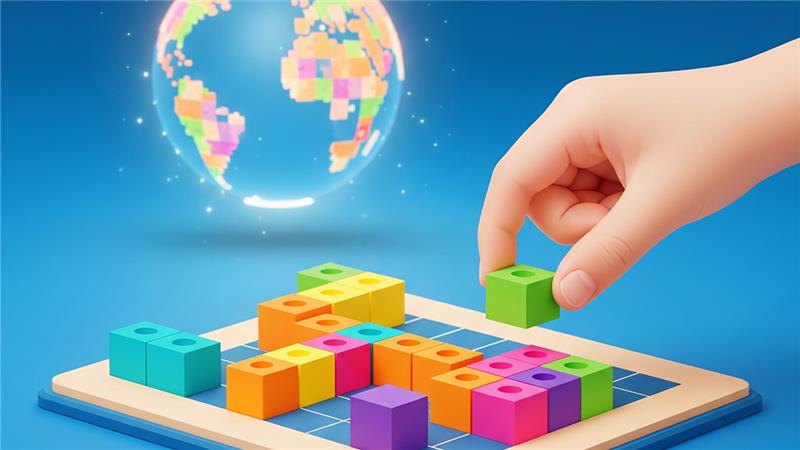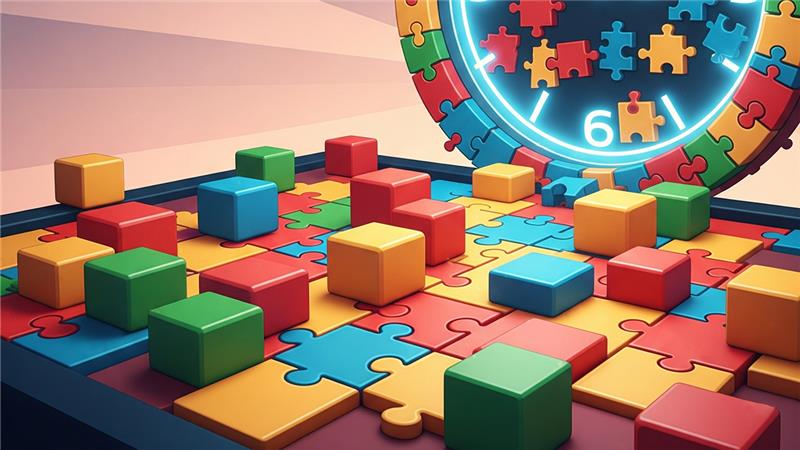Block puzzle games have captivated players for decades with their simple yet challenging mechanics. This blog explores their evolution from early classics like Tetris to modern mobile adaptations highlighting their timeless appeal, brain boosting benefits, and continued relevance in today’s gaming landscape.
Table of Contents
- Introduction
- A Brief History of Block Puzzle Games
- Core Mechanics That Make Block Puzzle Games Addictive
- The Psychology Behind the Popularity
- Mobile Gaming and the 2000s Boom
- The Social Side of Block Puzzle Gaming
- The Social Side of Block Puzzle Gaming
- Conclusion
1. Introduction
- Block puzzle games have captivated players for decades with their deceptively simple gameplay and endless opportunities for strategic thinking.
- These games, centered around arranging blocks to fit within a grid or clear lines, first gained widespread popularity in the 1980s and 1990s but truly exploded in the 2000s with the advent of mobile gaming. Today, they remain a staple of casual gaming, appealing to players of all ages.
- In this blog, we’ll explore the evolution of block puzzle games, their key mechanics, the psychology behind their popularity, and their impact on the gaming industry. Whether you’re a long time fan or a newcomer, this deep dive will help you appreciate the humble yet mighty block puzzle game.
2. A Brief History of Block Puzzle Games
The story of block puzzle games begins in 1984 with the release of Tetris, created by Russian software engineer Alexey Pajitnov. Tetris introduced the world to a simple yet profoundly engaging concept: falling tetrominoes that players must rotate and place to form complete lines. The success of Tetris laid the groundwork for an entire genre.
Throughout the 1990s, various developers experimented with the formula, resulting in games like Dr. Mario, Columns, and Puyo Puyo. However, it wasn’t until the 2000s that block puzzle games truly found a new home: mobile phones. The accessibility and portability of these devices allowed block puzzle games to reach a broader audience than ever before.
Games like Blockudoku, 1010!, and Wood Block Puzzle emerged, combining classic mechanics with modern aesthetics and user-friendly interfaces. These titles solidified block puzzle games as a dominant force in mobile gaming.
3. Core Mechanics That Make Block Puzzle Games Addictive
Several core mechanics contribute to the addictive nature of block puzzle games:
- Simplicity: The rules are easy to understand, making them accessible to players of all ages and backgrounds.
- Progressive Difficulty: The games often start easily but become increasingly challenging, keeping players engaged.
- Instant Feedback: Players receive immediate results from their actions, which reinforces learning and encourages experimentation.
- Replayability: With each game session being different, players are encouraged to try again to beat their previous scores.
- Minimal Time Commitment: Most games can be played in short bursts, making them ideal for on-the-go entertainment.
These elements combine to create a compelling loop that keeps players coming back.
4. The Psychology Behind the Popularity
Block puzzle games tap into several psychological principles that explain their widespread appeal:
- Cognitive Challenge: These games stimulate the brain by requiring pattern recognition, spatial reasoning, and decision-making.
- Flow State: The balance between challenge and skill can induce a state of flow, a deeply satisfying mental state where players lose track of time.
- Reward Systems: Visual and auditory rewards for clearing lines or achieving combos provide positive reinforcement.
- Competence and Mastery: Players feel a sense of accomplishment as they improve their skills and achieve higher scores.
Because of these psychological factors, block puzzle games are often used as mental exercises and have even been incorporated into cognitive therapy.

5. Mobile Gaming and the 2000s Boom
- The 2000s marked a significant turning point with the proliferation of smartphones. App stores gave developers a new platform to distribute games globally. Block puzzle games, with their low resource demands and high replay value, quickly rose to the top of the charts.
- Games like Tetris Blitz, Unblock Me, and Jigsaw Puzzle Block reached millions of downloads. Developers began to add features such as daily challenges, leaderboards, and customizable themes to keep players engaged.
- Social media integration also helped popularize the genre, allowing players to share scores and compete with friends, adding a social element to a traditionally solitary activity.
6. Modern Variations and Innovations
While classic block puzzle mechanics remain popular, developers have introduced innovations to keep the genre fresh:
- Hybrid Gameplay: Games like Blockudoku mix Sudoku with block puzzles for a novel challenge.
- Story Integration: Some games incorporate narrative elements, giving context to puzzles and enhancing immersion.
- Themed Events: Seasonal themes and special events keep the game environment dynamic.
- Augmented Reality (AR): Emerging technologies are bringing block puzzle games into the real world, offering new ways to interact.
These innovations have helped block puzzle games maintain their relevance in a crowded app marketplace.
7. The Social Side of Block Puzzle Gaming
- Though traditionally single-player, block puzzle games have embraced social elements in recent years. Multiplayer modes, tournaments, and community challenges have turned solitary gameplay into shared experiences.
- Online communities and forums dedicated to specific games allow players to exchange tips, share high scores, and even design their own puzzles. This community aspect enhances engagement and builds loyalty among fans.
8. Conclusion
- In a world of ever-evolving technology and fleeting trends, block puzzle games remain remarkably enduring. Their simplicity, accessibility, and brain boosting benefits make them a unique blend of fun and functionality.
- As technology continues to evolve, we can expect block puzzle games to adapt and thrive in new environments. From their humble beginnings in Soviet software labs to their status as mobile game royalty, block puzzle games are more than just entertainment. They are a testament to the power of simple ideas executed brilliantly.
- Whether you’re playing for fun, mental fitness, or competition, block puzzle games offer something for everyone. Their legacy is not just in the games themselves, but in the millions of players they’ve engaged, challenged, and delighted over the years.





I’ve been following your blog for a while now, and this post might be your best one yet!
Thank you for your feedback! It’s great to know the post made an impact.
Your writing is so clear and concise. I’m always excited when you publish something new.
asd